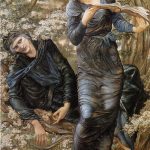When love and art intertwine, the result can be both beautiful and tumultuous. One of the most intriguing stories from the 19th century that captures this blend is the relationship between the acclaimed painter John Everett Millais and Effie Gray. Their romance was not just a simple love story but a complex narrative involving artistic triumphs, societal expectations, and personal liberation. Let’s delve into the lives of these two fascinating figures and explore how their paths crossed, leading to a tale that’s as captivating as any novel.
John Everett Millais was born on June 8, 1829, in Southampton, England. A child prodigy, he displayed exceptional artistic talent from a young age. By the age of eleven, Millais became the youngest student to enter the prestigious Royal Academy of Arts. His technical skill and innovative approach soon made him a prominent figure in the art world.
Millais co-founded the Pre-Raphaelite Brotherhood in 1848, alongside William Holman Hunt and Dante Gabriel Rossetti. This group aimed to return to the detail, intense colors, and complex compositions that characterized early Renaissance art before Raphael. Their work was a departure from the popular styles of the time, often invoking strong reactions from critics and the public alike.
The Pre-Raphaelite Brotherhood: Revolutionizing Art
The Pre-Raphaelite Brotherhood (PRB) sought to challenge the prevailing art conventions of the Victorian era. They emphasized naturalism, vibrant colors, and intricate details, often depicting scenes from literature, mythology, and nature. Millais’s early works, such as “Ophelia” (1851-52), exemplify these principles. “Ophelia” portrays the tragic character from Shakespeare’s “Hamlet,” floating in a river surrounded by lush flora, rendered with meticulous precision.
Millais’s affiliation with the PRB not only established his reputation but also positioned him at the forefront of an artistic revolution. His work was characterized by a keen observation of nature and a dedication to truth, often employing symbolism and narrative depth. As Millais’s career flourished, so did his personal life, setting the stage for his fateful encounter with Effie Gray.
Euphemia “Effie” Gray was born on May 7, 1828, in Perth, Scotland. Raised in a relatively affluent family, Effie was educated and well-traveled, qualities that distinguished her in Victorian society. In 1848, she married the influential art critic John Ruskin, a union that seemed promising given Ruskin’s stature and Effie’s charm.
However, the marriage was far from ideal. Ruskin’s inability to consummate the marriage and his controlling nature led to years of frustration and emotional turmoil for Effie. Despite these challenges, Effie remained resilient and sought solace in her social and artistic circles. Her friendship with the Pre-Raphaelite artists, including Millais, would soon become a pivotal aspect of her life.
The Intersection of Two Lives
Effie Gray first met John Everett Millais in 1853 when Ruskin commissioned Millais to paint his portrait. The trio traveled to Glenfinlas in Scotland, where Millais began his work on the painting. During this time, Millais and Effie grew close, finding comfort and companionship in each other’s company. Effie’s warmth and intelligence were a stark contrast to her cold and distant relationship with Ruskin.
As Millais painted Ruskin, he also sketched numerous portraits of Effie, capturing her beauty and spirit. The bond between Millais and Effie deepened, eventually blossoming into a passionate love affair. This relationship, however, was fraught with complications, given Effie’s marriage to Ruskin and the societal norms of the time.
Effie’s marriage to Ruskin reached a breaking point in 1854. She boldly sought an annulment, citing non-consummation as the reason. This decision was scandalous and courageous, given the rigid Victorian standards surrounding marriage and divorce. Effie’s determination and strength in pursuing the annulment were remarkable, highlighting her desire for personal freedom and happiness.
The annulment was granted in 1854, freeing Effie from her unhappy marriage. She married John Everett Millais on July 3, 1855. Their union marked the beginning of a new chapter, both in their personal lives and Millais’s artistic career.
Millais’s Transformation: From Pre-Raphaelite to Mainstream Success
Marriage to Effie brought significant changes to Millais’s life and work. While his early work with the Pre-Raphaelites was groundbreaking, his later career saw a shift towards more conventional subjects and styles. This transition was partly influenced by the need to support his growing family, as he and Effie had eight children.
Millais’s later works, such as “Bubbles” (1886) and “The Boyhood of Raleigh” (1870), reflect a more commercial and accessible approach. Despite this shift, Millais maintained his technical excellence and continued to receive critical acclaim. In 1885, he was awarded the title of Baronet, and in 1896, he became the President of the Royal Academy, solidifying his status as one of the leading artists of his time.
Effie’s influence on Millais extended beyond their personal relationship. She was his muse, providing inspiration and support throughout his career. Effie’s keen eye for art and her understanding of the social dynamics of the time helped Millais navigate the complexities of the art world.
Effie also played a crucial role in managing Millais’s affairs, ensuring the financial stability of their family. Her strength and resilience, honed during her troubled marriage to Ruskin, were invaluable in supporting Millais’s career. Effie’s contributions, often overlooked in historical accounts, were integral to Millais’s success and legacy.
The story of John Everett Millais and Effie Gray is a testament to the power of love, resilience, and artistic vision. Their relationship, marked by both triumphs and challenges, left an indelible mark on the art world. Millais’s work, spanning from the revolutionary Pre-Raphaelite movement to mainstream Victorian art, continues to be celebrated for its beauty and technical mastery.
Effie Gray’s legacy, too, deserves recognition. Her courage in seeking personal happiness and her role as a supportive partner to Millais are inspiring. Effie’s life story reflects the broader struggles and triumphs of women in the 19th century, navigating societal constraints to pursue their own paths.
The romance between John Everett Millais and Effie Gray was far from conventional. It defied the strict moral codes of Victorian society, highlighting the complexities of love and personal freedom. Their story resonates with themes of artistic innovation, personal liberation, and the enduring power of love.
As we look back on the lives of Millais and Effie, we are reminded of the profound impact that personal relationships can have on artistic creation. Their love story, intertwined with the evolution of Victorian art, continues to captivate and inspire. In celebrating their legacy, we honor not just their individual achievements but the beautiful and tumultuous journey they shared together.
The Art of John Everett Millais: A Closer Look
To truly appreciate the impact of John Everett Millais on the art world, it’s essential to examine some of his most notable works. These pieces reflect his artistic evolution and the profound influence of his personal life, particularly his relationship with Effie Gray.
“Ophelia” (1851-52)
Perhaps one of Millais’s most famous paintings, “Ophelia,” epitomizes the Pre-Raphaelite Brotherhood’s principles. The painting depicts the tragic drowning of Ophelia from Shakespeare’s “Hamlet,” surrounded by an array of meticulously detailed flowers and foliage. The work is celebrated for its vibrant colors, intricate detail, and emotional depth. It remains a cornerstone of Pre-Raphaelite art and a testament to Millais’s early artistic vision.
“The Order of Release” (1852-53)
This painting, completed shortly after Millais met Effie, depicts a poignant moment during the Jacobite Rebellion. A weary soldier is released from prison, embraced by his devoted wife while their child clings to her skirts. The emotional intensity of the scene, combined with Millais’s attention to detail, showcases his ability to convey powerful narratives through his art.
“Bubbles” (1886)
One of Millais’s later works, “Bubbles,” represents his shift towards more commercial and accessible subjects. The painting, originally titled “A Child’s World,” was later used in an advertisement for Pears’ soap, leading to its widespread popularity. Despite its commercial associations, the painting is a delicate and charming portrayal of childhood innocence.
“The Boyhood of Raleigh” (1870)
This painting illustrates a young Sir Walter Raleigh listening intently to a sailor’s tales of adventure. The work reflects Millais’s skill in capturing historical and narrative scenes, imbued with a sense of wonder and curiosity. It remains a beloved piece, celebrated for its storytelling and craftsmanship.
Effie Gray: Beyond the Muse
While Effie Gray is often remembered in the context of her relationships with Ruskin and Millais, her own story is equally compelling. Effie’s resilience and determination to find happiness and personal fulfillment are inspiring, particularly within the restrictive confines of Victorian society.
Effie’s experiences and observations gave her a unique perspective on the social issues of her time. She was involved in various charitable activities, advocating for the rights and welfare of women and children. Effie’s commitment to these causes reflects her compassionate nature and her desire to effect positive change in society.
Effie’s role as Millais’s muse and partner cannot be overstated. Her presence in his life provided emotional support and artistic inspiration, influencing many of his works. Effie’s understanding of art and her keen eye for detail helped Millais navigate the complexities of the art world, ensuring his continued success.
The story of John Everett Millais and Effie Gray transcends their personal lives, offering insights into the broader cultural and social dynamics of the 19th century. Their relationship highlights the intersections of art, love, and societal expectations, providing a lens through which to explore these themes.
Millais’s work with the Pre-Raphaelite Brotherhood challenged the artistic conventions of the time, advocating for a return to naturalism and detailed observation. This movement, though initially controversial, paved the way for future artistic innovations and contributed to the evolution of modern art.
Effie’s courage in seeking an annulment and pursuing her happiness reflects the broader struggles for women’s rights and personal autonomy during the Victorian era. Her story is a testament to the resilience and determination of women who defied societal norms to forge their own paths.
The legacy of Millais and Effie continues to be celebrated in the art world and beyond. Millais’s contributions to art, from his Pre-Raphaelite masterpieces to his later commercial successes, remain influential and widely admired. Effie’s story, too, resonates with contemporary audiences, highlighting the enduring quest for personal freedom and fulfillment.
An Enduring Tale
The lives of John Everett Millais and Effie Gray offer a rich tapestry of love, art, and resilience. Their story, marked by both triumphs and challenges, continues to captivate and inspire. As we reflect on their legacy, we are reminded of the profound impact that personal relationships and societal dynamics can have on artistic creation.
In celebrating the enduring tale of Millais and Effie, we honor their contributions to art and their remarkable journey together. Their love story, intertwined with the evolution of Victorian art, remains a testament to the power of love, resilience, and artistic vision.




